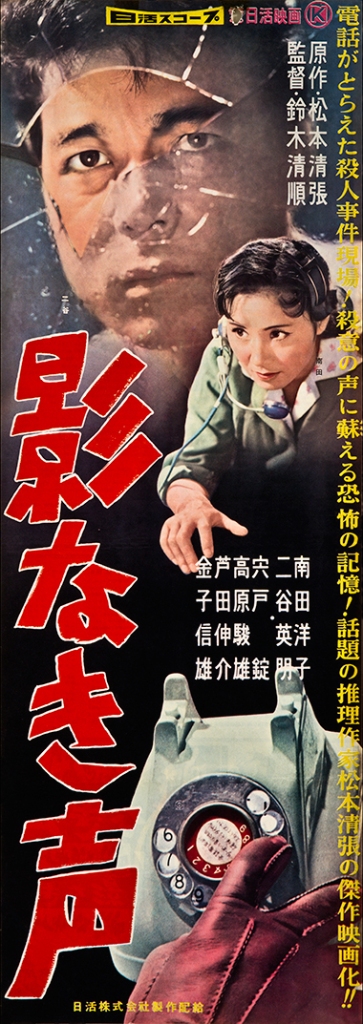Seijun Suzuki was a prolific director. For Nikkatsu alone, he directed 40 pictures from his debut in the ‘50s to his dismissal after 1967’s Branded to Kill.  Overlooked at the time, Youth of the Beast (1963) is now recognised as a turning point for his personal style. It is a film oversaturated with style, as if Suzuki approached every scene – every frame – with a playful, or perhaps unhinged, effort to make it interesting. He flips between black and white – with a single splash of colour – and full colour production. He pans the camera across a noisy cabaret bar, and abruptly cuts to a soundproof room, the volume dropping precipitously. A scene transition is smothered by a fan dancer. Conversations take place to a roiling backdrop of black and white movie footage from the office of a movie theatre. In one bonkers blink-and-you’ll miss it moment, star Jo Shishido (as Jo Mizuno) walks past a movie theatre covered in Nikkatsu bunting, complete with portraits of all the Nikkatsu stars – himself among them. All this contributes to a lively film that while perhaps not good is nevertheless great.
Overlooked at the time, Youth of the Beast (1963) is now recognised as a turning point for his personal style. It is a film oversaturated with style, as if Suzuki approached every scene – every frame – with a playful, or perhaps unhinged, effort to make it interesting. He flips between black and white – with a single splash of colour – and full colour production. He pans the camera across a noisy cabaret bar, and abruptly cuts to a soundproof room, the volume dropping precipitously. A scene transition is smothered by a fan dancer. Conversations take place to a roiling backdrop of black and white movie footage from the office of a movie theatre. In one bonkers blink-and-you’ll miss it moment, star Jo Shishido (as Jo Mizuno) walks past a movie theatre covered in Nikkatsu bunting, complete with portraits of all the Nikkatsu stars – himself among them. All this contributes to a lively film that while perhaps not good is nevertheless great.
Tag: Seijun Suzuki
Review: Voice Without a Shadow (1958)
Watching foreign language films as an English speaker, you’re necessarily limited by the availability of films that have been translated and released in your local region.  That means the quality and availability of Japanese films with English language subtitles (ignoring for a moment the often very fine work of fansubbers) is not necessarily representative of the quality or breadth of Japanese cinema in general. This is even more true when looking back at older films; while a contemporary film might at least get a limited release in the West, older films by lesser known directors or even by well-respected auteurs can be difficult to find. Even Akira Kurosawa’s outsized shadow over Japanese cinema doesn’t mean it’s possible to find all his films on DVD, let alone restored on Blu-ray. That’s why I’m so thrilled to have outfits like Arrow Video, Masters of Cinema, and the Criterion Collection that put out restored copies of both classic and obscure films. Arrow, in particular, deserves commendation for being much broader in what it will publish; it’s not that every lesser-known work is a forgotten classic, but it would be a real shame to lose these titles forever.
That means the quality and availability of Japanese films with English language subtitles (ignoring for a moment the often very fine work of fansubbers) is not necessarily representative of the quality or breadth of Japanese cinema in general. This is even more true when looking back at older films; while a contemporary film might at least get a limited release in the West, older films by lesser known directors or even by well-respected auteurs can be difficult to find. Even Akira Kurosawa’s outsized shadow over Japanese cinema doesn’t mean it’s possible to find all his films on DVD, let alone restored on Blu-ray. That’s why I’m so thrilled to have outfits like Arrow Video, Masters of Cinema, and the Criterion Collection that put out restored copies of both classic and obscure films. Arrow, in particular, deserves commendation for being much broader in what it will publish; it’s not that every lesser-known work is a forgotten classic, but it would be a real shame to lose these titles forever.
All that is a long preamble to introducing Arrow Video’s “Nikkatsu Diamond Guys” series. With two volumes so far, that’s six lesser known works from some cult directors that might not otherwise see the light of day again. Let’s start with Seijun Suzuki’s Voice Without a Shadow (1958).
Review: Branded to Kill (1967)
It didn’t take much research into Japanese film before Seijun Suzuki’s name came up.  Specifically, it was an anecdote about his film Branded to Kill (1967): a film so far removed from his orders to create a B-movie about a hitman, to fill out the back half of a double bill, that he was promptly fired by the studio. The movie is now regarded as an avant-garde masterpiece, and I knew that I had to see it.
Specifically, it was an anecdote about his film Branded to Kill (1967): a film so far removed from his orders to create a B-movie about a hitman, to fill out the back half of a double bill, that he was promptly fired by the studio. The movie is now regarded as an avant-garde masterpiece, and I knew that I had to see it.
